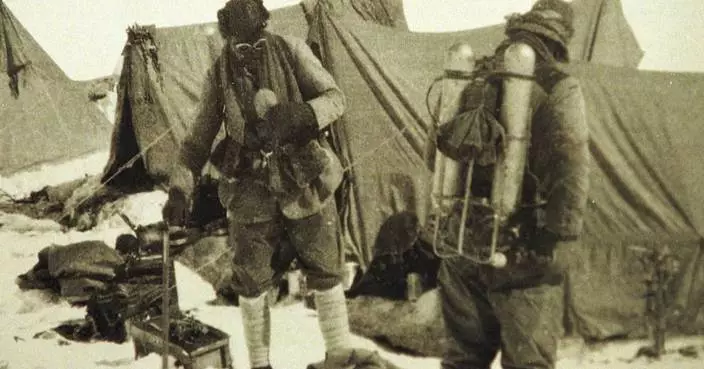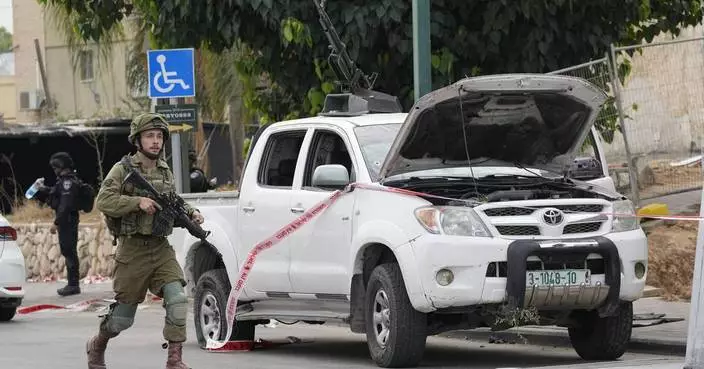America's annual joint military exercises with South Korea always frustrate North Korea. The war games set to begin Monday may hold more potential to provoke than ever, given President Donald Trump's "fire and fury" threats and Pyongyang's as-yet-unpursued plan to launch missiles close to Guam.
Will the allies keep it low-key, or focus on projecting strength? An examination of this year's drills and how the North might respond to them:
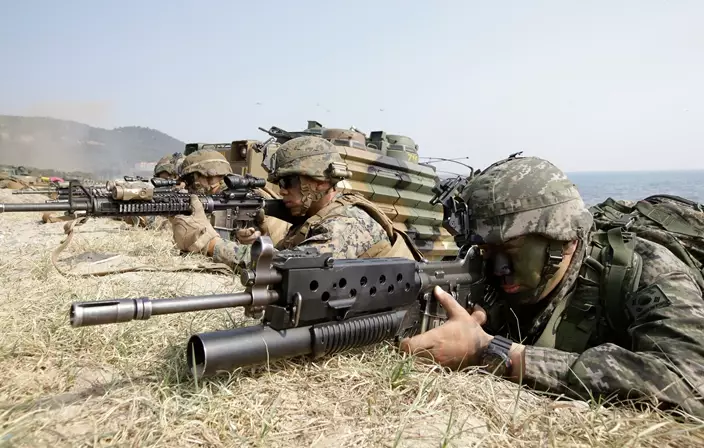
FILE - In this March 30, 2015, file photo, Marines of South Korea, right and the U.S aim their weapons near amphibious assault vehicles during the U.S.-South Korea joint landing military exercises. (AP Photo/Lee Jin-man, File)
THE WAR GAMES
The Ulchi Freedom Guardian drills will be the first joint military exercise between the allies since North Korea successfully flight-tested two intercontinental ballistic missiles in July and threatened to bracket Guam with intermediate range ballistic missile fire in August.
Despite some calls to postpone or drastically modify drills to ease the hostility on the Korean Peninsula, U.S. and South Korean military officials say that the long-scheduled exercises will go ahead as planned.
The drills, which began in the 1970s and involved 25,000 American and 50,000 South Korean soldiers last year, consist mainly of computer simulations aimed at honing joint-decision making and planning and improving command operations. The United States and South Korea also hold larger war games in the spring, called Key Resolve and Foal Eagle, which involve live-fire exercises and training with tanks, aircraft and warships.
There's media speculation that the allies might try to keep this year's drills low-key by not dispatching long-range bombers and other U.S. strategic assets to the region. But that possibility worries some, who say it would send the wrong message to both North Korea and the South, where there are fears that the North's advancing nuclear capabilities may eventually undermine a decades-long alliance with the United States.
"If anything, the joint exercises must be strengthened," Cheon Seongwhun, who served as a national security adviser to former conservative South Korean President Park Geun-hye, said in an interview.
Impoverished North Korea hates the drills in part because it must frequently respond with its own expensive displays of military might.
During last year's drills, the North successfully test-fired for the first time a submarine-launched ballistic missile ruler Kim Jong Un then praised as the "success of all successes." Shortly after the drills, the North carried out its fifth and biggest nuclear test, which it claimed was of a "standardized" warhead that could fit on a variety of its rockets.
During this year's war games in March, North Korea launched four extended-range Scud missiles into the sea in what it described as a rehearsal for striking U.S. military bases in Japan.
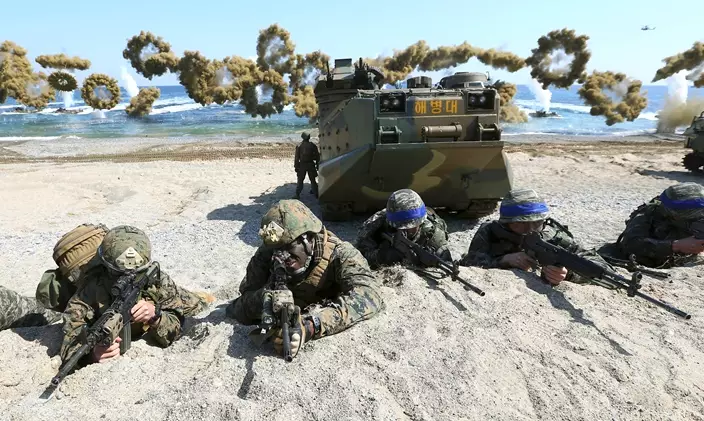
FILE - In this March 12, 2016 file photo, Marines of the U.S., left, and South Korea wearing blue headbands on their helmets, take positions after landing on a beach during the joint military combined amphibious exercise. (Kim Jun-bum/Yonhap via AP, File)
MISSILE THREATS
It's almost certain that this year's drills will trigger some kind of reaction from North Korea. The question is how strong it will be.
Some experts say North Korea is mainly focused on the bigger picture of testing its bargaining power against the United States with its new long-range missiles and likely has no interest in letting things get too tense during the drills.
If this is right, expect the usual propaganda belligerence in state media or low-level provocations like artillery and short-range missile drills.
"North Korea has already flight-tested ICBMs twice this year and will probably take a wait-and-see approach to assess the impact of stronger pressure from the United States and China and maybe even seek an opportunity for talks, rather than quickly move forward with another test," said Moon Seong Mook, a former South Korean military official and current senior analyst for the Seoul-based Korea Research Institute for National Strategy.
But the North might use the drills as an excuse to conduct another ICBM test or maybe even act on its threat to lob missiles into the waters near Guam.
"North Korea is probably looking at all the cards it has to maximize pressure against the United States, and the drills provide a good opportunity to do it," Cheon said.
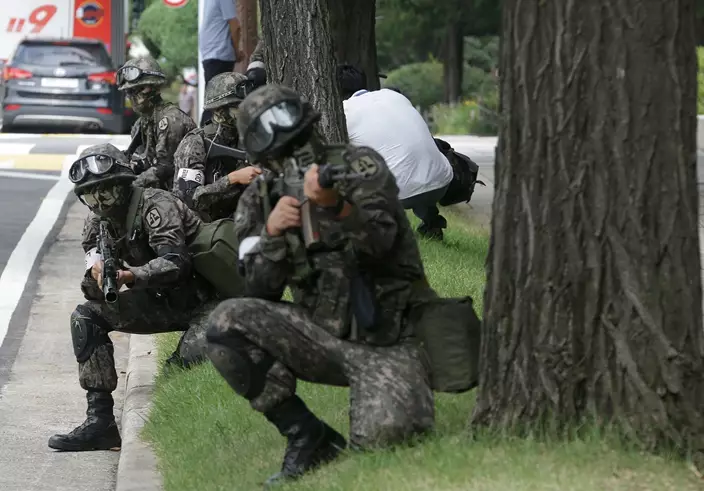
FILE- In this Aug. 24, 2016, file photo, South Korean army soldiers conduct an anti-terror drill as part of Ulchi Freedom Guardian exercise, at the National Assembly in Seoul, South Korea. (AP Photo/Ahn Young-joon, File)
WORRIES ABOUT THE FUTURE
There are calls in both the United States and South Korea for the allies to pause or downsize the joint military exercises to reduce strain and potentially persuade North Korea into talks to freeze its nuclear program.
David Wright, a U.S. analyst from the Union of Concerned Scientists, said in an emailed statement that the United States should "postpone or significantly restructure" the exercises to reduce the risk of military confrontation.
"Smart military planning means ensuring that exercises do not enflame an already tense situation," Wright said.
South Korea's Kyunghyang Shinmun newspaper said in an Aug. 11 editorial that the allies could gain a bargaining chip in efforts to persuade the North into meaningful nuclear talks by halting or scaling down the joint drills.
"The U.S.-South Korean drills aren't a sacred realm," the newspaper said, referring to the time that Washington and Seoul agreed to cancel their large-scale Team Spirit drills in the early 1990s to induce the North to join denuclearization talks.
These arguments might not win over South Korean conservatives whose main fear is that a fully functional ICBM in Pyongyang would eventually force the United States to consider a peace treaty with the North and also the removal of the tens of thousands of American soldiers stationed in South Korea.
While expressing a desire to reach out to the North, South Korea's liberal President Moon Jae-in has also ordered his military officials to schedule talks with the United States to increase the warhead limits on South Korean missiles, and his prime minister said recently that the country should also consider acquiring nuclear-powered submarines to better cope with North Korean threats.
Some conservatives want more strength, however, and are calling for the United States to bring back the tactical nuclear weapons that were withdrawn from the South in the 1990s.
KYIV, Ukraine (AP) — Ukrainian President Volodymyr Zelenskyy said a Russian missile strike that smashed a prominent skyline television tower in Kharkiv was part of the Kremlin’s effort to intimidate Ukraine’s second-largest city, which in recent weeks has come under increasingly frequent attack.
The strike sought to “make the terror visible to the whole city and to try to limit Kharkiv’s connection and access to information,” Zelenskyy said in a Monday evening address.
The northeastern Kharkiv region straddles the approximately 1,000-kilometer (600-mile) front line where Ukrainian and Russian forces have been locked in battle for more than two years since Moscow’s full-scale invasion of Ukraine. The front line has changed little during a war of attrition, focused mostly on artillery, drones and trenches.
Since late March, Russia has stepped up the pressure on Kharkiv, apparently aiming to exploit Ukraine’s shortage of air defense systems. It has pounded the local power grid and hit apartment blocks.
On Monday, a Russian Kh-59 missile struck Kharkiv’s 250-meter (820-foot) -high TV tower, breaking it roughly in half and halting transmissions.
A Washington think tank said Russia may be eyeing a ground assault on Kharkiv.
“The Kremlin is conducting a concerted air and information operation to destroy Kharkiv City, convince Ukrainians to flee, and internally displace millions of Ukrainians ahead of a possible future Russian offensive operation against the city or elsewhere in Ukraine,” the Institute for the Study of War said in an assessment.
The expected arrival in Ukraine in coming weeks of new military aid from its Western partners possibly has prompted Russia to escalate its attacks before the help arrives, the ISW said, adding that trying to capture Kharkiv would be “a significant challenge” for the Kremlin’s forces.
Instead, the Russian military command “may attempt to destroy Kharkiv City with air, missile, and drone strikes and prompt a large-scale internal displacement of Ukrainian civilians,” it said.
The U.S. Senate was returning to Washington on Tuesday to vote on $61 billion in war aid to Ukraine after months of delays. Zelensky said U.S. President Joe Biden assured him the aid would include long-range and artillery capabilities.
“Four priorities are key: defense of the sky, modern artillery, long-range capacity, and to ensure that packages of American aid arrive as soon as possible,” Zelenskyy said.
Also Tuesday, Britain pledged 500 million pounds ($620 million, 580 million euros) in new military supplies for Ukraine, including 400 vehicles, 60 boats, 1,600 munitions and 4 million rounds of ammunition.
The shipment will also include British Storm Shadow long-range missiles, which have a range of about 150 miles (240 kilometers) and have proven effective at hitting Russian targets, the British government said.
British Prime Minister Rishi Sunak spoke with Zelenskyy on Tuesday morning to confirm the new assistance. He was due to announce the aid later Tuesday during a visit to Warsaw where he was meeting with Polish Prime Minister Donald Tusk and NATO Secretary General Jens Stoltenberg.
Less cheering news came from the European Union, however. EU countries that have Patriot air defense systems gave no clear sign Monday that they might be willing to send them to Ukraine, which is desperately seeking at least seven of the missile batteries.
Ukraine’s army is also heavily outnumbered in the fight, and expanding the country’s mobilization has been a delicate issue.
Ukrainian Foreign Minister Dmytro Kuleba on Tuesday signaled that authorities plan to clamp down on young men of conscription age who have moved abroad, with details of the specific measures to be made public soon.
“Staying abroad does not relieve a citizen of his or her duties to the homeland,” Kuleba said on the social media platform X.
Meanwhile, Russia launched 16 Shahed drones and two Iskander-M ballistic missiles over Ukraine’s southern and central regions, the Ukrainian air force said Tuesday morning. It said all but one of the drones were intercepted.
In Odesa, an overnight attack injured nine people, regional Gov. Oleh Kiper said. Among those injured were two infants and two children aged nine and 12, Kiper said. City mayor Hennadii Trukhanov said 58 apartments in 22 buildings were damaged.
In other developments:
A Russian missile strike near Dnipro, Ukraine’s fourth-largest city, injured four people who were admitted to hospital, regional Gov. Serhii Lysak said.
Russian forces dropped a guided aerial bomb in Kostiantynivka, a city in the eastern Donetsk region, injuring five people who were riding in a car, police said. Two of them were in critical conditions.
Follow AP’s coverage of the war in Ukraine at https://apnews.com/hub/russia-ukraine
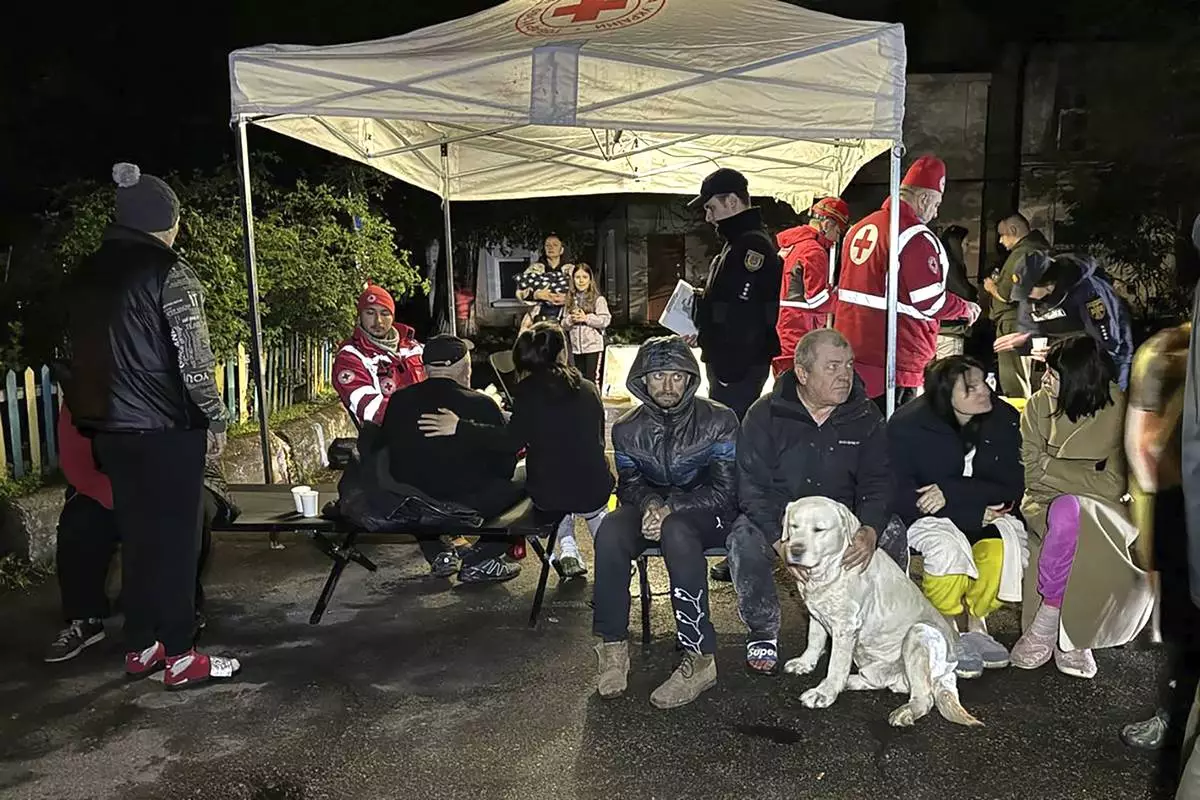
In this photo provided by the Mayor of Odesa Hennadii Trukhanov in Telegram, residents gather outside of an apartment block after a Russian drone attack in Odesa, Ukraine, Tuesday, April 23, 2024. (Mayor of Odesa Hennadii Trukhanov via AP)

In this photo provided by the Ukrainian Emergency Service, a search dog with its handler look for survivors after a Russian drone attack in Odesa, Ukraine, Tuesday, April 23, 2024. (Ukrainian Emergency Service via AP)
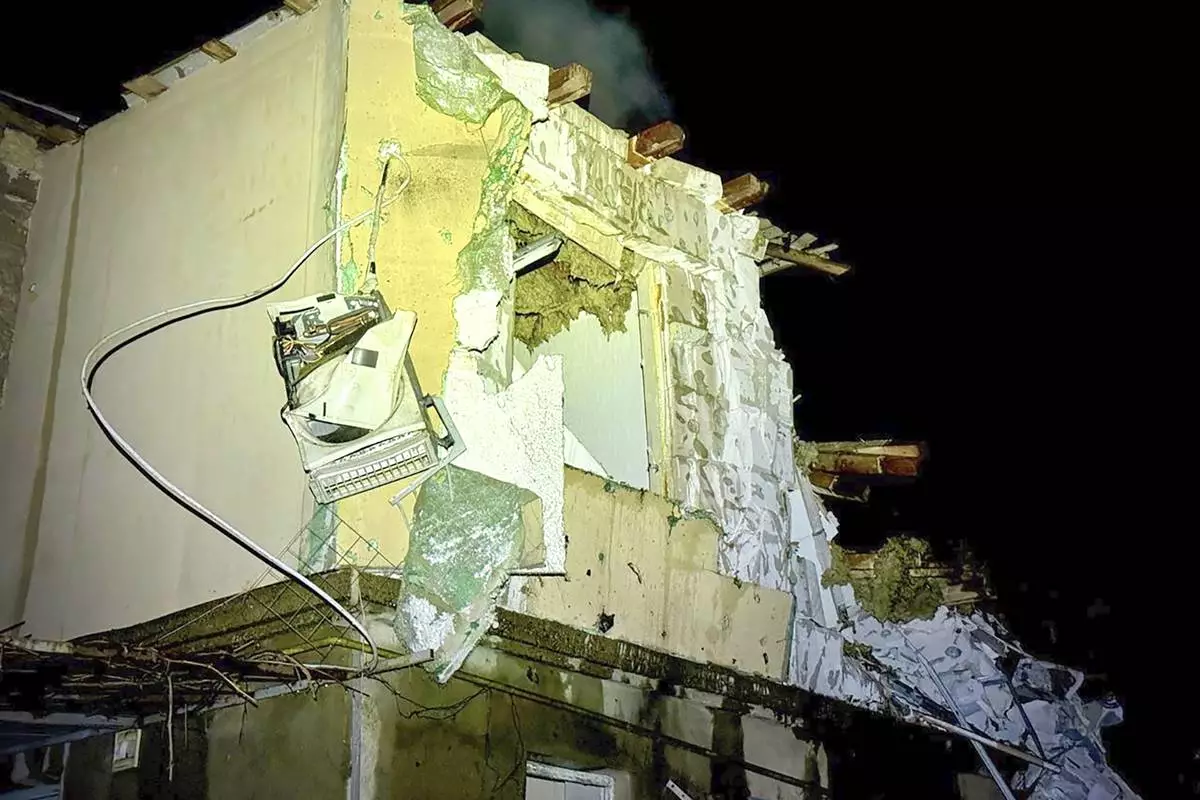
In this photo provided by the Mayor of Odesa Hennadii Trukhanov in Telegram, a view of the damage after a Russian drone attack in Odesa, Ukraine, Tuesday, April 23, 2024. (Mayor of Odesa Hennadii Trukhanov via AP)
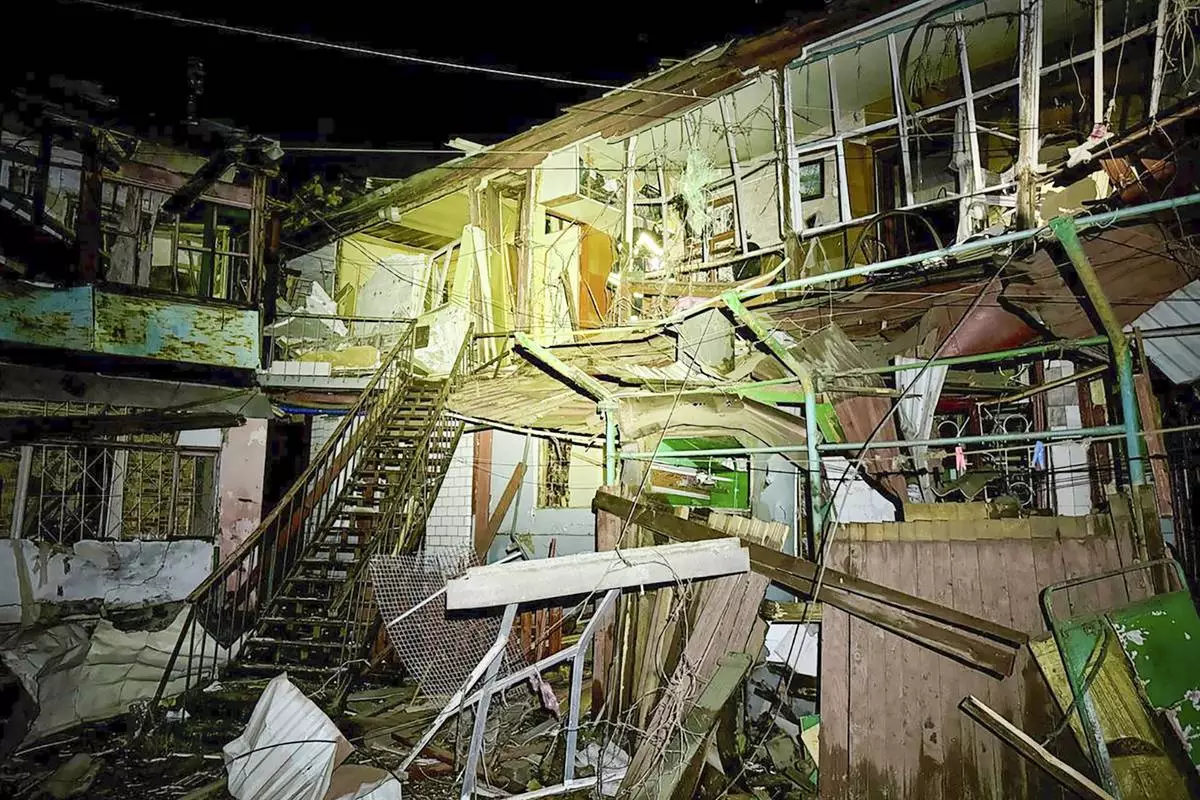
In this photo provided by the Mayor of Odesa Hennadii Trukhanov in Telegram, a view of the damage after a Russian drone attack in Odesa, Ukraine, Tuesday, April 23, 2024. (Mayor of Odesa Hennadii Trukhanov via AP)

In this photo provided by the Mayor of Odesa Hennadii Trukhanov in Telegram, firefighters work on the site of a damaged building after a Russian drone attack in Odesa, Ukraine, Tuesday, April 23, 2024. (Mayor of Odesa Hennadii Trukhanov via AP)
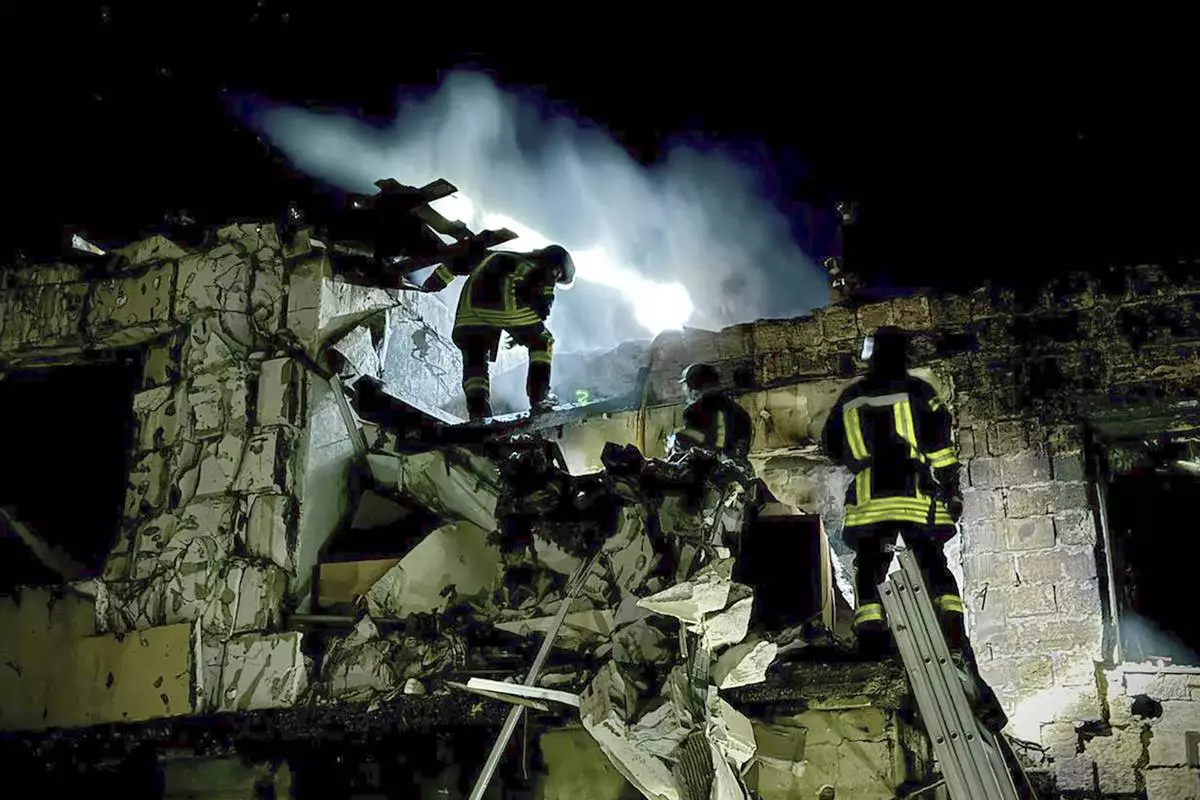
In this photo provided by the Mayor of Odesa Hennadii Trukhanov in Telegram, firefighters work on the site of a burning building after a Russian drone attack in Odesa, Ukraine, Tuesday, April 23, 2024. (Mayor of Odesa Hennadii Trukhanov via AP)
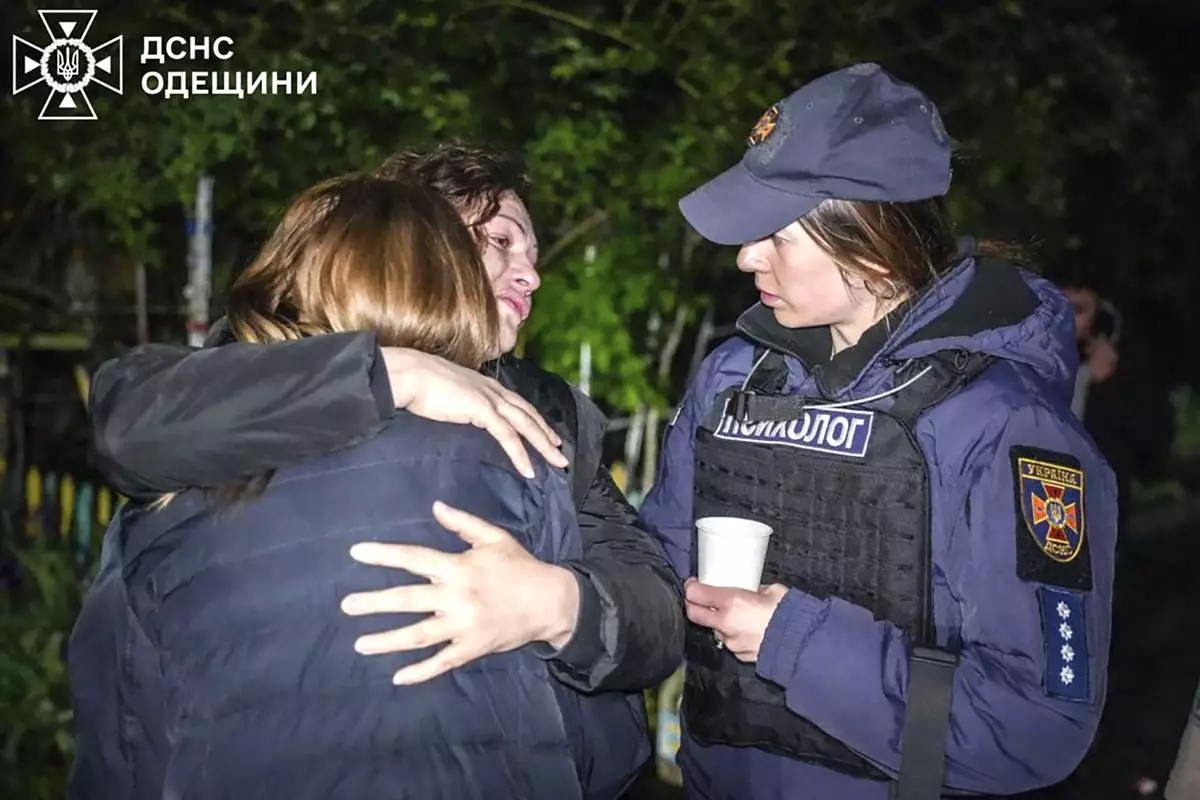
In this photo provided by the Ukrainian Emergency Service, emergency service psychologist, right, comforts women at the scene of a building that was damaged by night Russian drone attack in Odesa, Ukraine, Tuesday, April 23, 2024. (Ukrainian Emergency Service via AP)

In this photo provided by the Ukrainian Emergency Service, emergency service psychologist, left, comforts a woman at the scene of a building that was damaged by night Russian drone attack in Odesa, Ukraine, Tuesday, April 23, 2024. (Ukrainian Emergency Service via AP)
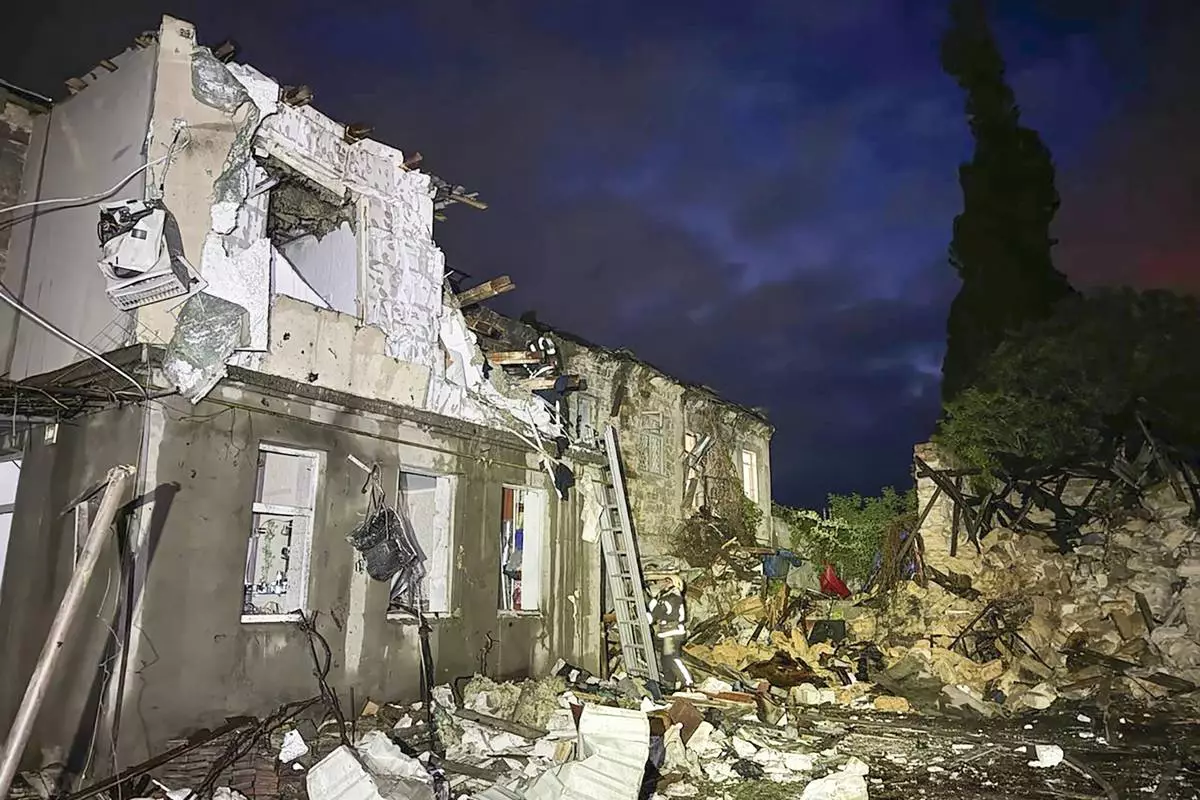
This photo, provided by head of the Odesa Regional Military Administration Oleh Kiper, firefighters work on the site of a damaged building after a Russian drone attack in Odesa, Ukraine, Tuesday, April 23, 2024. (Head of the Odesa Regional Military Administration Oleh Kiper via AP)
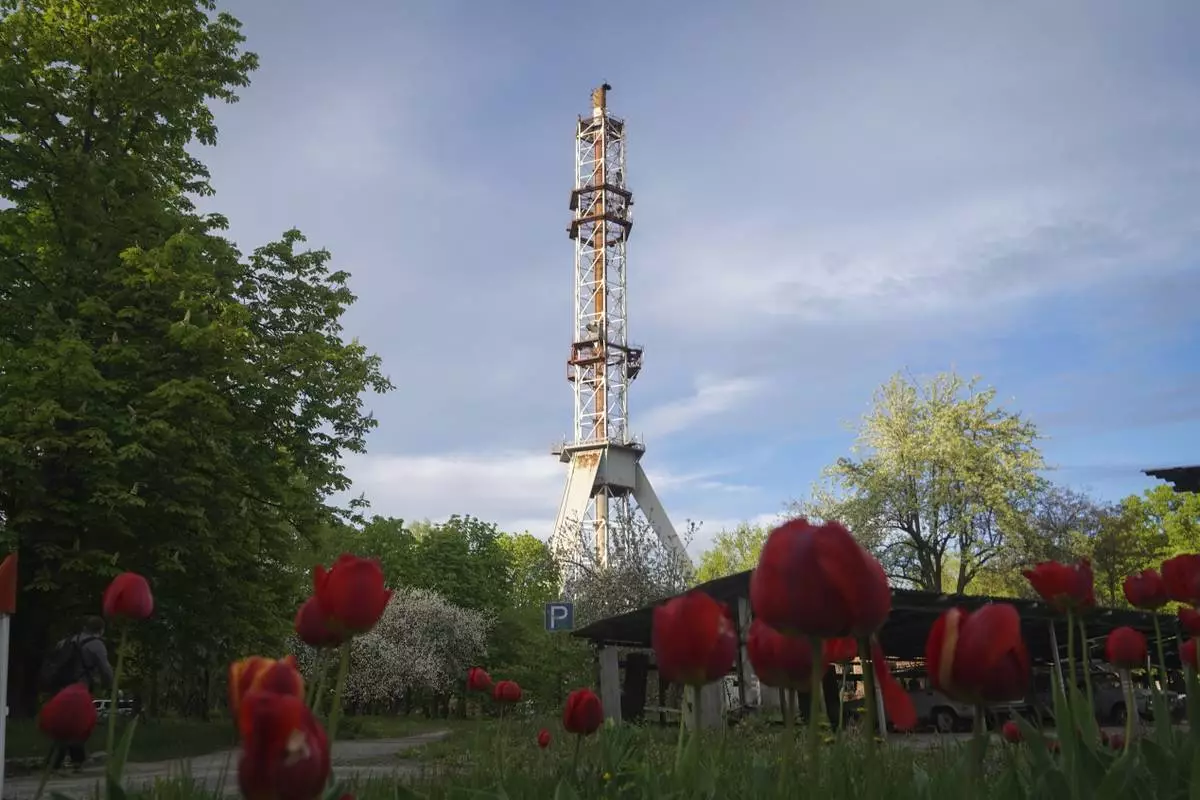
A view of the television tower broken in half after it was hit by a Russian missile in Kharkiv, Ukraine, Monday, April 22, 2024. (AP Photo/Andrii Marienko)
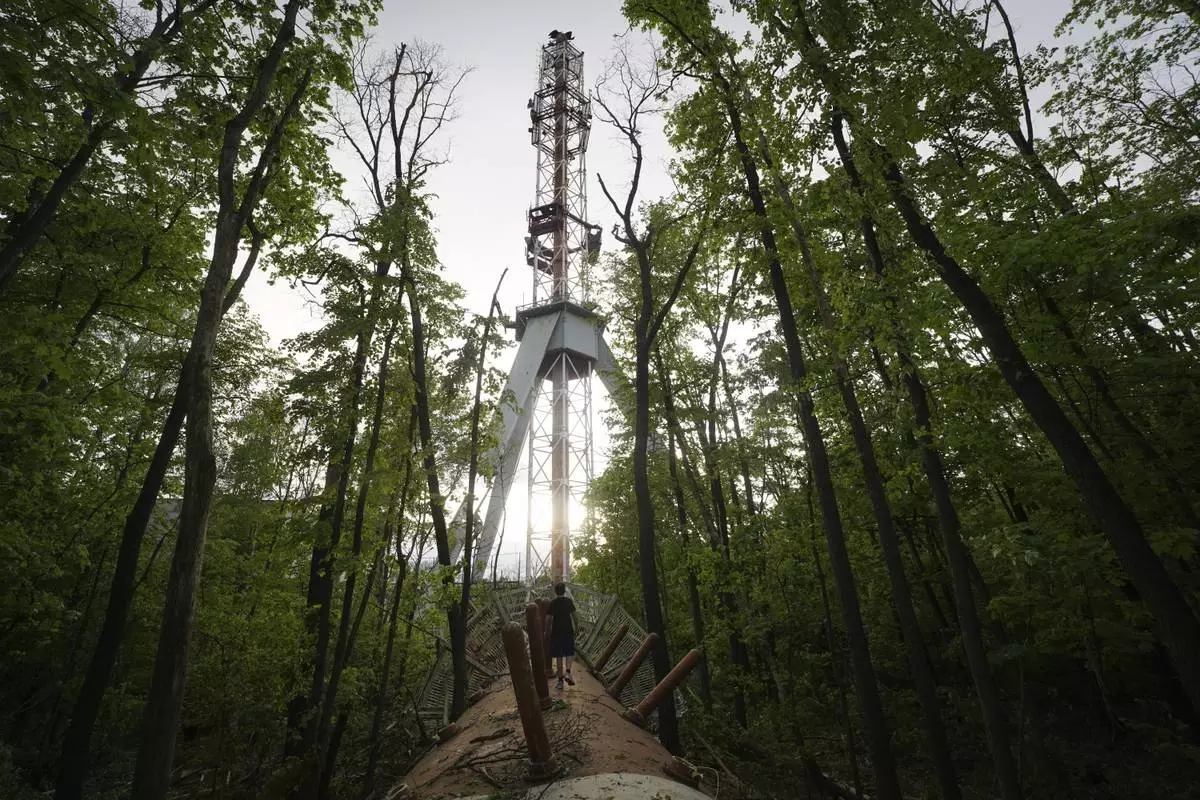
A view of the television tower, broken in half after it was hit by a Russian missile in Kharkiv, Ukraine, Monday, April 22, 2024. (AP Photo/Andrii Marienko)
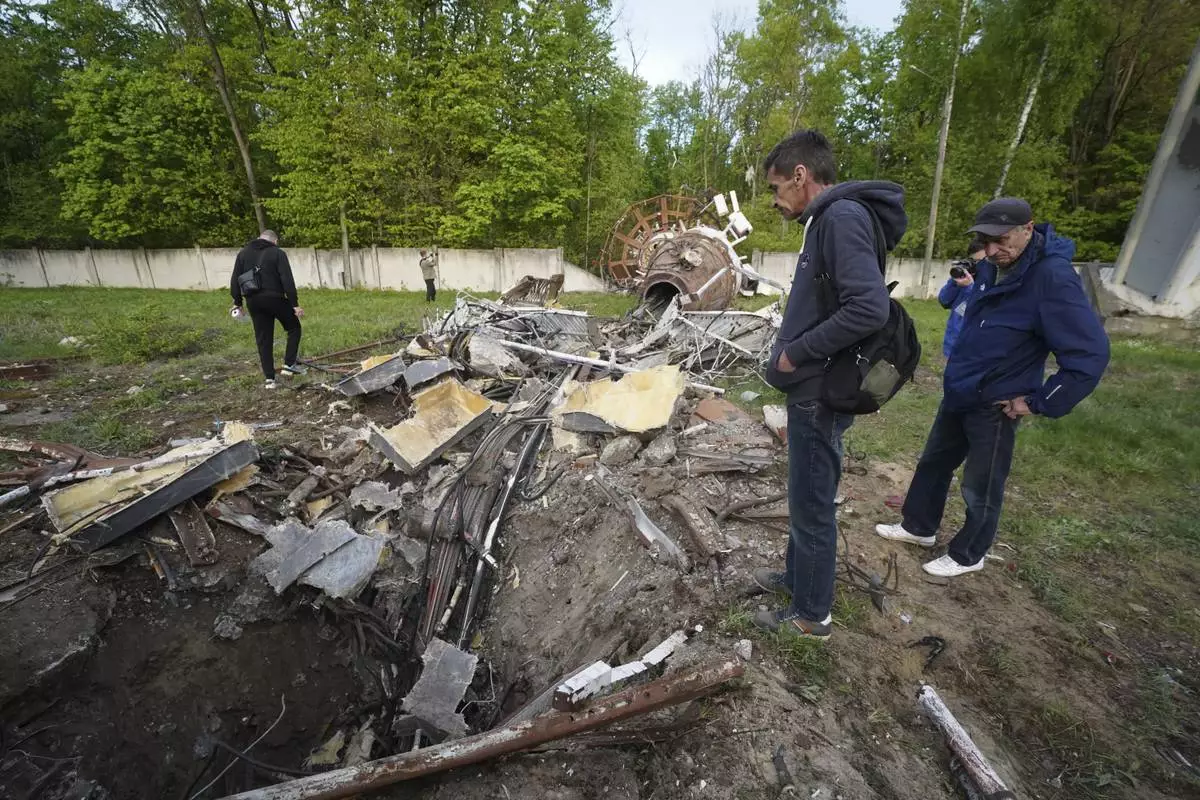
People look at fragments of the television tower which was broken in half after it was hit by a Russian missile in Kharkiv, Ukraine, Monday, April 22, 2024. (AP Photo/Andrii Marienko)




















